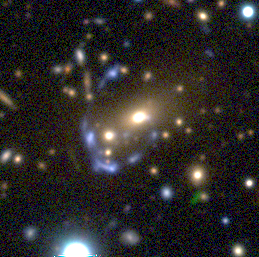Gravitational lensing (Strong, Weak and Micro)
Gravitational lensing is the deflection of light from a distant source due to the gravitational potential of an intervening mass to the observer. In weak lensing, we carry out a statistical study of weaker distortions to the distant galaxies due to massive galaxies or galaxy clusters at lower redshifts. In strong lensing, multiple images of a distant source such as a galaxy or a quasar are formed which allow us to address many questions related to cosmology and galaxy formation and its evolution. In extra-galactic microlensing, the compact stellar population causes perturbations to the properties of the strongly lensed images.
At IUCAA, research is ongoing in diverse areas of strong lensing from galaxies to cluster-scales using data from large imaging surveys such as the Hyper-Suprime Cam Survey and the Dark Energy Survey. LSST Survey data, in the near future, will also offer exciting challenges for detecting and analyzing large samples of gravitational lenses. The (strong/micro-)lensing of gravitational waves is also one of the research focuses at IUCAA.
 |
| A strong gravitational lens discovered from the Hyper Suprime Cam (HSC) Survey shows a galaxy group (yellow galaxies) lensing distant galaxies in the background (multiple blue knots and arcs). Detailed analysis of such systems can help probe the mass distribution of such galaxy groups and improve our understanding of the role of dark matter and the luminous mass (stars+gas). |


